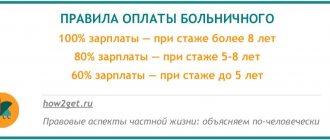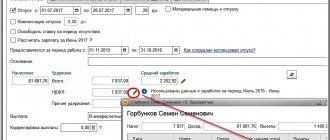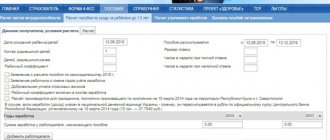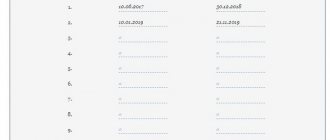Home / Labor Law / Labor Code / Work experience
Back
Published: 05/17/2016
Reading time: 7 min
0
2363
According to labor legislation, every working citizen has the right to receive twenty-eight days of rest time from his employer annually. And for some categories of employees, an additional vacation period is added to the standard vacation (Article 116 of the Labor Code).
To receive such leave, the employee must accumulate a certain length of service, which, according to the Labor Code, will allow the employer to send the employee on vacation . This period is paid for the employee. And you can count on it only after working at a specific enterprise for a certain period established by labor legislation.
- When is the vacation issued?
- What does the vacation period depend on?
- Experience accounting
- How is the calculation made?
- Accounting in enterprise documents
How is leave granted and when?
As a general rule, the duration of the main vacation is 28 calendar days for a full year worked. The employee may also be granted additional leave, for example, for special working conditions or for long work experience. That is why the duration of vacation for some employees can be up to 45 days.
The fact that the main vacation is granted for a full calendar year does not mean that the employee must work continuously for a year without the right to rest. It is established by law that annual paid leave can be granted to an employee for the first time after 6 months of his work.
Accordingly, if, as a general rule, an employee is entitled to 28 days of rest for a full calendar year, after six months he can use at least 14 days. However, by agreement with the employer, full leave can be provided in advance, that is, before the end of the calendar year; this is not prohibited by the legislator.
In this case, there is one nuance, and the employee and employer need to understand that the provision of annual paid leave is accompanied by the payment of vacation pay. And if an employee quits without working for a full year, while using the entire vacation period and receiving vacation pay in full, a difficult situation may arise between the employee and the employer regarding the return of the overpaid amount.
So, how to correctly calculate the vacation period? What day does the billing period begin?
Calculation of rest duration
In order to calculate the duration of release from official duties, the period of work of the person for the previous year is taken into account. This period includes:
- time of direct work activity;
- periods when an employee is on leave without pay (no more than 14 days per billing period);
- time of release from official obligations with retention of wages;
- being on a business trip;
- undergoing training from the organization;
- time of illness (if a properly executed sick leave is provided);
- forced downtime due to unjustified dismissal or removal from office with subsequent reinstatement;
- impossibility of fulfilling labor obligations due to lack of a medical examination, provided that the medical examination is absent for reasons beyond the employee’s control.
Periods that are not taken into account when calculating the duration of rest:
- downtime due to the fault of the employee: absenteeism, showing up at work drunk;
- child care time up to 1.5 years;
- unpaid days off longer than 14 days.
It is possible not to use the entire vacation at once. By agreement between the employee and the employer, it can be divided into several parts. The main thing is that the first period is at least 2 weeks.
The duration of vacation is calculated in calendar days. Days recognized as days off in a particular organization are included in the total duration of paid rest. Holidays recognized as days off at the government level are not included in the period of release from work. If a holiday falls during the rest period, the exemption from work is extended by the number of these days off. This provision is spelled out in Article 120 of the Labor Code of the Russian Federation.
If you take days off from March 1, 2021 to March 14, 2018, then you need to start work on March 15, 2021. However, during the holiday there is a holiday - March 8th. Consequently, the weekend should be extended by 1 day, and the citizen will return to work only on March 16.
If an employee falls ill while on vacation, this period is not included in its duration. The basis for extending the exemption from official duties is the provided sick leave. The employee has the right to take advantage of additional days of rest immediately or add them to the time of the next release from work. The selected option must be agreed upon with the head of the organization.
According to Article 286 of the Labor Code of the Russian Federation, citizens working part-time in an organization must be granted leave simultaneously with a period of rest at their main place of work.
How is the vacation period calculated?
And if the situation with the billing period for a full calendar year is clear, then what to do if the year is not fully worked out, on what basis is the number of vacation days calculated?
As the legislator established, vacation is calculated according to the following principle: for each full month worked, the employee is entitled to 2.3 days of rest (main vacation).
However, a situation may arise in which an employee works for less than a full month, how to calculate in this case? If an employee works 14 or more days in a month, a rest period of 2.3 days is accrued for such a month; if the period worked in a month is less than 14 days, no vacation is assigned for such a month.
As previously established, annual paid leave is a period of legal rest for an employee; for this period, wages must be maintained and paid to the employee in the form of vacation pay. How to correctly calculate wages for a given period?
Important factors for determining length of service
There are several important factors that must be taken into account when determining the length of leave:
- Understand the difference between a working year and a calendar year.
- The calendar year is constant and runs from January 1st to December 31st.
- A working year means twelve months of continuous work for the same employer. For each employee it is individual and may change as certain periods are excluded from the length of service. Therefore, the beginning of the working year is considered to be the first day of work for a particular employer. Subsequent working years begin on the day following the end of the previous working year.
- Correctly determine the periods included in the length of service and giving employees the right to annual paid leave.
- Keep in mind that vacation experience is lost when you change jobs. To qualify for leave, an employee must have continuous service with the same employer .
- Keep in mind that work experience acquired from a previous employer is not counted . After an employee’s dismissal from the company, all necessary calculations are made, including payment of compensation for vacation that was not used by him.
When calculating average earnings, which periods are taken into account and which are excluded?
An employee's salary may vary throughout the year and amounts may vary significantly. On what basis then should pay be calculated for the vacation period? This amount is calculated based on the employee’s average earnings.
This average salary is calculated according to the following principle: wages for twelve months are summed up, the resulting amount is divided by 12, and then divided by 28.4 (the established average duration of a working month).
If the employee worked for less than 12 months, the salary for the period worked is summed up, divided by the number of months in the period, then also divided by 28.4. Using this formula, the average salary for one day is determined; in order to calculate the full amount, the resulting figure must be multiplied by the number of vacation days.
For example, if it is known that the employee worked for six months. Salaries were: January - 10,000 rubles, February - 10,000 rubles, March - 10,000 rubles, April - 15,000 rubles, May - 15,000 rubles, June - 15,000 rubles. The total amount for the period worked was 75,000 rubles. To calculate average earnings - 75,000/6/28.4 = 440.14. The resulting amount represents the average earnings for one day.
If the employee is given 14 days of leave, then 440.14*14= 6,161.96. This amount must be paid to the employee for the period of his vacation.
When making these calculations, it is necessary to understand that the calculation of average earnings includes all amounts received by the employee, with the exception of amounts of financial assistance that were not assigned for labor merit, for example, upon the birth of a child or on anniversaries.
What periods are included in the vacation period?
According to the law, there are several types of periods that must be included in the vacation period. Each of them should be considered in detail.
Actual work under the employment contract
The period of actual work of an employee under an employment contract implies the performance of his job duties while at a permanent workplace, as well as on business trips.
There is an exception to the rule that you need to know about: the vacation period cannot include the work time of a citizen who works in a company on the basis of a civil law contract. This is due to the fact that there is no labor relationship between the parties who entered into such an agreement. Therefore, there is no legal basis for providing employees with paid leave.
There are situations where an employee initially worked under a civil contract, and subsequently entered into an employment contract with the employer. Thus, the length of service required to provide paid leave will begin to count from the first day of work in the company.
After six months of continuous work, the employee has the right to vacation.
Trial period
During the probationary period, the employee is subject to the provisions of labor legislation and other regulatory legal acts, which contain all the norms of labor law. In this regard, the probationary period is taken into account when granting paid leave.
Periods with retention of position and workplace in the event of actual non-fulfillment of work.
In accordance with current legislation and other regulatory legal acts, the position held and place of work is retained by the citizen during the following periods:
- Basic and/or additional paid leave provided annually;
- Holidays;
- Weekend;
- Additional days of rest provided by the employer.
Article 112 of the Labor Code of the Russian Federation specifies the following holidays, which must be taken into account when calculating an employee’s vacation experience: January 1, 2, 3, 4, 5, 6 and 8 (New Year holidays), January 7 (Christmas), February 23 (Defender’s Day Fatherland), March 8 (International Women's Day), May 1 (Spring and Labor Festival), May 9 (Victory Day), June 12 (Russia Day), and November 4 (National Unity Day).
The total vacation period includes time:
- An employee's stay on study leave,
- Passing an independent qualification assessment (as directed by the employer), as well as obtaining additional education to facilitate career advancement.
Long leave for a teaching staff member
After a 10-year continuous working period, employees of the teaching sector are granted the right to a long vacation, which can last up to one year. This information is specified in Article 335 of the Labor Code of the Russian Federation.
A long vacation included in the length of service gives the right to the basic paid vacation provided to employees annually.
There are no regulations regulating the procedure for granting teachers long leaves. In this case, one should take into account, approved by order of the Ministry of Education and Science of the Russian Federation dated May 31, 2016 No. 644, the regulation on the procedure and conditions for granting long leave - up to 1 year.
Leave without pay granted at the request of an employee
Letter No. 854-6-1 of Rostrud dated June 14, 2012 explains that the total duration of unpaid leave should be no more than 14 calendar days during the working year. If an employee has a total duration of such vacations for the working year of 19 calendar days, then when calculating the length of service, calendar days starting from the 15th are not taken into account.
In accordance with Part 2 of Article 121 of the Labor Code of the Russian Federation, if any periods were not included in the length of service for vacation, then the end of the working year is shifted by exactly as many calendar days as were excluded from the length of service for vacation.
A disabled employee is entitled to 60 days of leave without pay. If the employer grants him leave without pay for more than 14 days, will the working period of the main leave shift in this case?
In this case, if a disabled person is provided with 60 calendar days of unpaid leave during the year, then 14 of them are included in the length of service giving the right to annual basic paid leave, and 46 are not.
Inter-shift period at the enterprise
Article 299 of the Labor Code of the Russian Federation states that a shift is a period that includes the performance of work at the site, as well as rest between shifts. Part 1 of Article 297 of the Labor Code of the Russian Federation defines the rotation method - a special form of conducting the labor process outside the places of permanent residence of employees. There is a regime that determines rest days for rotation workers.
Part 1 of Article 121 of the Labor Code of the Russian Federation states that the length of service considered when assigning leave includes the time when the employee did not actually work, but the position he held was retained. Consequently, the working period that grants the right to leave must include the inter-shift period.
Rest days provided by the employer for overtime work
Article 99 of the Labor Code of the Russian Federation gives the following definition of overtime work: any work performed by an employee on the initiative of the employer outside working hours established by law. At the same time, the duration of overtime work is limited by law - no more than four hours over a continuous two-day period. Annually - no more than 120 hours for each employee.
Guided by Article 152 of the Labor Code of the Russian Federation, an employee has the right, instead of increased pay for overtime work, to receive additional time for rest. In total, it should not be less than the time spent on overtime work. This echoes Article 121 of the Labor Code of the Russian Federation, according to which the vacation period may include days of rest provided to the employee on an individual basis, including for overtime work.
Maternity leave
Based on an application and a medical report, women are granted maternity leave, which is entirely included in the leave period. Depending on the presence of complications and the number of children born, its duration can range from 120 to 194 calendar days .
Part-timer's leave
In addition to his main job, an employee may have a part-time job. How to combine vacations in this case? For such categories of workers, the legislator has established a certain guarantee. It lies in the fact that leave from a part-time job is necessarily granted to the employee simultaneously with leave from the main place of work, regardless of the period worked by the part-time worker.
That is, in the case of external part-time work, the employee applying for leave must, along with the application, provide a certificate from his main place of work stating that he is granted annual paid leave for a certain period. If the question concerns internal part-time work, in this case everything is a little simpler; the employee writes two applications for leave (for each position) addressed to the employer. Refusal to grant leave to a part-time worker in this situation is unacceptable.
This kind of measure is provided so that the employee can get proper rest, because it is impossible to be on vacation half-time.
Period of work when granted annual leave
Labor legislation assigns the employee the right (and the employer, accordingly, the obligation) to provide him with an annual long period of rest, during which he retains both his workplace and average earnings (Article 114 of the Labor Code of the Russian Federation). The minimum number of rest days is 28 calendar days (Article 115 of the Code of the Russian Federation) and can be increased both by law (for certain professions) and by a document valid for a specific employer.
In addition to the main annual leave, an employee may have the right to additional annual leave (Article 116 of the Labor Code of the Russian Federation), which is caused by the presence of:
- harmful/dangerous working conditions;
- special requirements for the work performed;
- irregular working hours;
- special climatic conditions.
The minimum length of additional leave is also regulated by law (Articles 117-119 of the Labor Code of the Russian Federation), and it can also be increased by a document adopted by a specific employer.
Both types of annual leave are tied to a specific period of time for which they must be granted. This period corresponds to a year. But not calendar, but worker, counted as a period of time equal to a year from the date of employment to the employer sending the employee on vacation.
Useful information from ConsultantPlus
What is the working year for annual leave?
There is no normative definition for this concept. It is considered that a working year is a full 12 months of actual work and other periods taken into account in the length of service for such leave. The working year is counted not from January 1, as a calendar year, but from the date the employee was hired. But the end of the working year (and, accordingly, the beginning of the next working year) may be shifted (when the length of service for vacation is not enough) and, in terms of calendar months, the working year may be longer than 12 months (read more...).
In addition to working time, periods of absence from work are counted towards the length of service giving the right to basic annual rest (Article 121 of the Labor Code of the Russian Federation):
- justified, during which the employee retains his job and average earnings (in particular, the time spent on business trips, vacations, and weekly rest);
- through no fault of the employee;
- within 14 calendar days (in total for the year) in connection with taking leave without pay.
The following periods of absence from work are excluded from this period:
- Without good reason;
- in connection with parental leave;
- on days of vacation without pay that exceed 14 days included in the length of service.
Other special cases
In addition to annual paid leave, some categories of employees may be granted additional leave, as well as study leave:
- Additional vacation. This type of leave is provided in accordance with current legislation. For some categories of employees, this provision of this leave is mandatory, as evidenced by regulatory legal acts. However, the employer is not prohibited from independently establishing this type of leave for those positions that are not provided for by law. During the period of additional leave, as in the case of the main leave, wages are maintained.
- Study leave. This type of leave is provided to those persons who, along with performing their work functions, receive education at any educational institution. The employer is obliged to provide leave to this category of employees; this leave is not related to the main and additional annual leave. That is, if an employee has the right to these types of leaves, he can receive them in full for a certain period. However, there is a limitation with higher education. An employee has the right to receive paid study leave only after receiving his first higher education.
- Unused vacation. A situation often arises when an employee, having worked for a certain period of time, quits without using his right to leave. In this situation, upon dismissal, compensation for unused vacation must be transferred to the employee along with the payment. The period is calculated according to the general rule.
Previously, there were frequent cases when employees did not use the right to leave and continued to work, receiving compensation in monetary terms. Today, this practice is prohibited by law in relation to primary leave. Only days of additional leave may be subject to monetary compensation.
This rule was introduced primarily to protect workers from unscrupulous employers who do not want to provide annual paid leave.
So, the main points for calculating vacations have been considered. Having an understanding of the intricacies of granting vacations, both the employee and the employer will be able to protect themselves in labor relations.
Making a vacation schedule
There is just over a month left to draw up and approve a vacation schedule. We will tell you in the article how to prepare it correctly and what points should be taken into account.
According to paragraph 5 of Article 37 of the Constitution of the Russian Federation, every citizen working under an employment contract is guaranteed annual paid leave. The order of granting vacations to employees of one organization is determined by the vacation schedule (Part 1 of Article 123 of the Labor Code of the Russian Federation). TO COMPLETE OR NOT TO COMPLETE?
In many organizations, there is no vacation schedule; employees go on vacation in agreement with the manager. This practice violates the rights of the employee, since he is deprived of the opportunity to plan his rest time and organize it in the most effective way. Sometimes an employee cannot take advantage of the guaranteed right to rest during the calendar year at all.









